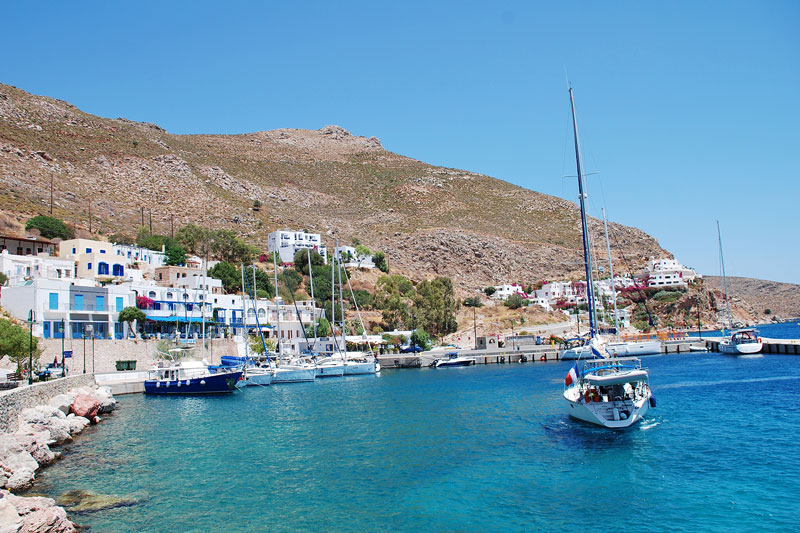This is the most southerly group of Greek islands, and only Crete lies closer to Africa. In summer the temperature can soar, which is what brings the sun worshippers flocking to their sand and shingle beaches.
Sunshine is guaranteed, and in some islands water shortages can occur. In spring the islands are green from winter rain, but by the time autumn comes around they have been burnt as brown as any sunbather. The islands string out along the coast of Turkey, and only became part of Greece in 1948.
They range from the big package-holiday destinations such as Kos and Rhodes to tiny specks like Kastellorizo, which is closer to Tukey than it is to any other Greek island. The Dodecanese also contain gems like Symi, arguably one of the most beautiful of all Greek islands, the holy island of Patmos, and islands where tourism has not yet swamped the local culture, like Tilos and Leros.
Itinerary – Kos & The Dodecanese

Day 1 – Rhodes
By far the largest and historically the most important of the Dodecanese islands, Rhodes abounds in beaches, wooded valleys and ancient history. Whether you’re here on a culture-vulture journey through past civilisations, or simply for some laidback beach time, buzzing nightlife, or diving in crystal-clear waters, it’s all here. The atmospheric Old Town of Rhodes is a maze of cobbled streets that will spirit you back to the days of the Byzantine Empire and beyond. Further south, in the picture-perfect town of Lindos, capped by an ancient Acropolis, sugar-cube houses spill down to a turquoise bay. While both Lindos and Rhodes Old Town get very crowded in summer, Rhodes is large enough to allow plenty of room to breathe that pure Aegean air.
Day 2 – Symi
Beautiful Symi is guaranteed to evoke oohs and aahs from visitors before you have even got off your yacht. The first sight of Gialos harbour, framed against an amphitheatre of pastel-coloured houses rising on all sides, is unforgettable. It’s all thanks to the Italians, who ruled the island almost a century ago and established the neoclassical architectural style that Symi has followed ever since. Although Symi is far from small, it's mostly barren and the only settlements are Gialos, the old village of Horio, which sprawls over the hilly ridge behind, and Pedi, down in the valley beyond. One road runs all the way to the monastery at Panormitis, near Symi’s southern tip. The rest of the island is largely deserted, but it's surrounded by blue coves and small beaches.


Day 3 – Nisyros
Arriving in Nisyros, taking in the crater of its volcano, has visitors wondering if they have landed on another planet. The crater cradles the midsummer heat and turns it into a cauldron, even by Greek standards, and the ground crunches beneath your feet, with clusters of sulphur crystals. But the island has much more to offer around the little port of Mandraki, with its postcard pretty-white houses and its winding narrow streets. The north coast is where some development has taken place with the road leading to Loutra and beyond to the best beach at Paloi.
Day 4 – Kos
Fringed by the finest beaches in the Dodecanese, dwarfed beneath mighty crags, and blessed with lush valleys, Kos is an island of endless treasures. Visitors soon become blasé at sidestepping the millennia-old Corinthian columns that poke through the rampant wildflowers – even in Kos Town, the lively capital, ancient Greek ruins are scattered everywhere you turn, and a mighty medieval castle still watches over the harbour. Away from the resorts, the island retains considerable wilderness, with the rugged Dikeos mountains soaring to almost 850m just a few kilometres west of Kos Town.


Day 5 – Tilos
Tilos is an island with rough, mountainous, and verdant volumes, hills and plains where four hundred species of flowers and herbs germinate, inhabited by numerous species of rare birds. This is a place with picturesque villages and charming beaches, where the last elephants of Europe lived: The dwarf-elephants appeared on the island 45,000 years ago and disappeared 4,000 years ago. The whole island constitutes a vast ecological park and is protected by international treaties. In ancient times, Tilos was famous for its herbs and became prosperous during the classic period.
Day 6 – Chalki
West of Rhodes lies a chain of islets, the biggest of them being Chalki. This is a place to relax and rejuvenate in typical Aegean Sea Island surroundings. An island with a low profile and an ancient history, it has been inhabited since the prehistoric times and is named after the copper mines (Chalkos is Greek for copper) that were in use on the island in antiquity. The buildings bear the signs of prosperity the island knew during the second half of the 19th century, as trade grew and the sponge harvesting business brought wealth to the locals.

